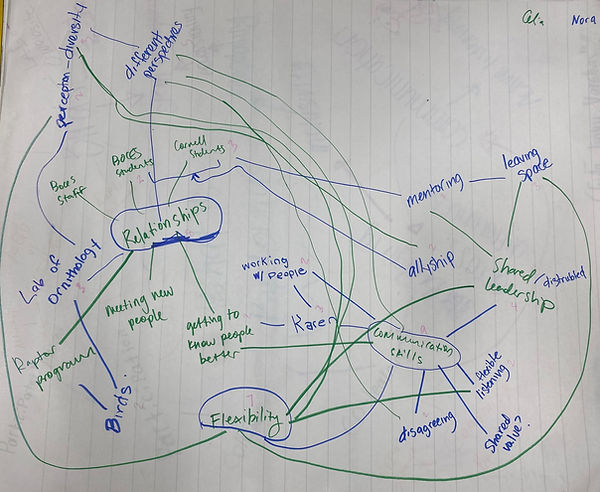...An individual’s social world emerges from, and persists within, their sensory experiences.

Our Goals
Central Frameworks
Example Semester Timeline
Week 1
Cornell students: introductions, course overview, and setting up reflective journals.
Location: Cornell campus.
Week 2
Cornell students: activity to reflect on how we engage in science outreach.
Location: Museum of the Earth.
Week 3
Cornell students: discuss and reflect on the different methods to assess science outreach programs.
Location: Cornell campus.
Week 4
Cornell and BOCES students: Meet in the classroom and introduce selves, make nametags, get to know each other and share learning goals and interests.
Location: BOCES campus.
Weeks
5 & 6
Cornell and BOCES students: birding-related activities (e.g., learn to use binoculars or meet with educators at the Cornell Lab of Ornithology).
Location: BOCES campus, CLO visitor center, Stewart Park.
Week 7
Cornell students: Debrief, reflective journaling, and propose outreach projects.
Location: Cornell campus.
Weeks
8-12
Cornell and BOCES students: Develop outreach projects.
Location: BOCES campus, CLO visitor center, Stewart Park.
Week 13
Cornell and BOCES students: Refine outreach projects.
Location: BOCES campus.
Week 14
Cornell and BOCES students: Share outreach projects with each other as well as other BOCES classes.
Location: BOCES campus.
Example Outreach Projects
These are activities and materials co-developed by BOCES and Cornell students throughout the Spring '25 semester.
Goal: Tell stories about birds - weaving together fun narratives and real facts and details about different bird species.
Development process: First we realized we a shared interest we had was telling funny stories that might explain the different bird behavior we would observe. This gave us the idea to build fold learning more about birds into a story-telling game. First we tried using bird oracle cards as a prompt for the story-telling. While that worked great, we decided to add more bird facts onto the cards themselves to make it easier to merge the two types of stories. We also made different 'scene' or place settings so that people could select different areas to have tell their story.
Materials developed: We purchased already designed bird oracle cards, which depict real species. We then added additional real bird facts onto these cards, and created laminated 'scenes' depicting different types of ecosystems.
Activity description: In a group, people take turn selecting one or two of the bird oracle cards. They choose a name for their bird characters. Then going around in a circle, they co-create a shared story - choosing different scenes - and weaving together real details about the birds (e.g. a puffins beak visible by its 'glow'). Collectively when a particular story is over, the group decides to shuffle the cards and start again!
Program Assessment
Students in the Birdsong Program learn about and perform a variety of methods of assessment ofoutreach programs. One of the principal methods we use is reflective journaling throughout the semester. Through regular, low-stakes writing entries students are able to engage personally with ideas they encounter during the semester, and see how their understanding deepens and changes (Dukewich & Vossen, 2015).
Another assessment method we utilize is Ripple Effect Mapping, an activity in which participants map out the impactful people, lessons, and other components of a program. This activity enables us to identify who the program affects, what lessons the program helps us learn, and what aspects of the program we see as the most meaningful.
Dukewich, K. R., & Vossen, D. P. (2015). Toward Accuracy, Depth and Insight: How Reflective Writing Assignments Can Be Used to Address Multiple Learning Objectives in Small and Large Courses. Collected Essays on Learning and Teaching, 8, 97–110. https://doi.org/10.22329/celt.v8i0.4258

Ripple Effect Map, Celia McLean and Nora Prior, Spring '25